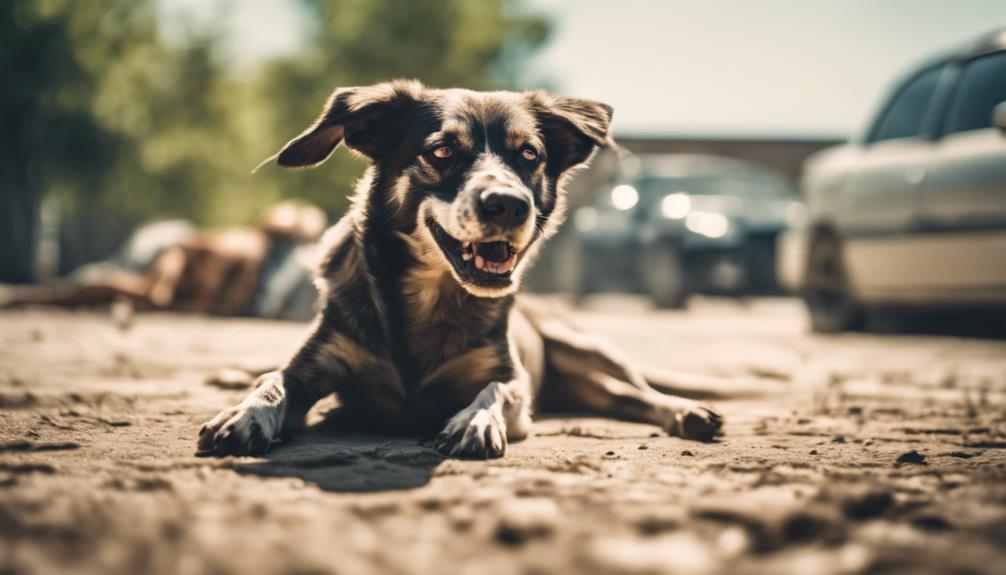As the mercury climbs and summer approaches, it becomes paramount for pet owners to be cognizant of the risks associated with heat exhaustion in dogs. The vulnerability of our canine companions to heat-related ailments cannot be overstated, necessitating a proactive approach to safeguarding their well-being.
Understanding the early warning signs, implementing preventive measures, and knowing how to respond in case of heat-related emergencies are vital components of responsible pet ownership.
Stay tuned to discover essential tips and strategies to ensure your furry friend stays cool and safe during the sweltering days ahead.
Key Takeaways
- Dogs regulate temperature through panting and cool surfaces, but can overheat easily.
- Recognize signs of heat exhaustion like excessive panting and vomiting in dogs.
- Treat heat exhaustion with cool, wet towels, elevation, water, and vet guidance.
- Prevent heat-related issues by monitoring, providing shade, and avoiding hot pavement for dogs.
Understanding Heat Regulation in Dogs
In dogs, the regulation of body temperature is crucial for their well-being and is primarily achieved through mechanisms such as panting and seeking cool surfaces. Due to their inability to sweat like humans, canines rely on these methods to prevent overheating.
Dogs can overheat at lower temperatures compared to humans, with a normal body temperature ranging between 101-103°F. Certain factors, such as breed characteristics like being brachycephalic, older age, being overweight, or lacking acclimation to heat, can increase the risk of heat exhaustion. Additionally, dogs with specific coat types, such as hairless, long/thick-coated, or short/thin-coated breeds, are also more vulnerable.
Understanding these aspects of heat regulation in dogs is essential for preventing heat-related illnesses and ensuring the well-being of our canine companions.
Recognizing Risk Factors for Heat Exhaustion
Consistently monitoring and understanding the key risk factors associated with heat exhaustion in dogs is paramount for responsible pet ownership and proactive prevention strategies.
- Brachycephalic breeds are more prone to heat exhaustion due to their anatomy.
- Older dogs have a harder time regulating their body temperature.
- Overweight dogs are at higher risk due to the extra insulation.
- Dogs unacclimated to heat may struggle in hot weather conditions.
- Specific coat types like hairless, long/thick-coated, or short/thin-coated can contribute to heat retention.
Differentiating Heatstroke Vs. Heat Exhaustion

Understanding the distinction between heatstroke and heat exhaustion in dogs is crucial for recognizing and responding effectively to potential heat-related emergencies. Heat exhaustion is the precursor to heatstroke, characterized by excessive panting, dehydration, and elevated body temperature up to 104°F. Dogs with heat exhaustion may show signs of weakness, vomiting, and diarrhea but can recover with prompt cooling measures.
On the other hand, heatstroke is a severe condition where the body temperature exceeds 105°F, leading to organ failure, seizures, and even death if not treated immediately. Differentiating between the two conditions is vital as heatstroke requires immediate veterinary intervention, while heat exhaustion can often be managed at home with appropriate cooling techniques and rest.
Signs and Treatment of Heat Exhaustion
Recognizing the early signs and promptly administering appropriate treatment are crucial in managing heat exhaustion in dogs.
- Excessive Panting: Dogs may excessively pant to try and cool down.
- Difficulty Breathing: Labored breathing can indicate a struggle to regulate body temperature.
- Increased Heart Rate: A rapid heart rate is a common sign of heat exhaustion.
- Vomiting: Dogs may vomit as their body tries to cope with the heat.
- Mild Weakness: Weakness or lethargy can be a warning sign of heat exhaustion.
Prompt treatment involves using cool, not cold, wet towels on the body, keeping the head elevated, offering cool water, and avoiding ice baths. Contacting a vet for further guidance and evaluation is crucial.
Long-Term Effects of Heat Exhaustion

In considering the aftermath of heat exhaustion in dogs, it is crucial to acknowledge the potential long-term effects that can arise from such an episode.
Heatstroke can have lasting implications on a dog's health, including kidney, heart, and neurological issues. Organ stress resulting from heatstroke may lead to the development of blood clots, further complicating the recovery process.
To minimize long-term complications, monitoring the dog's health, regular vet visits, and prompt intervention are essential. Seeking veterinarian consultation for any concerns regarding heat exhaustion in dogs is highly recommended to address and mitigate potential long-lasting impacts on the dog's well-being.
Vigilance and proactive measures can significantly contribute to safeguarding a dog's health following a heat exhaustion incident.
Prevention Strategies for Heat Exhaustion
To safeguard your dog's well-being and prevent heat exhaustion, implementing proactive measures and strategic interventions is paramount.
- Ensure access to fresh water at all times.
- Limit outdoor activities during peak heat hours.
- Provide ample shade and cool resting areas.
- Never leave your dog unattended in a parked car.
- Monitor your dog for signs of overheating regularly.
Additional Tips for Hot Weather Safety

During hot weather, prioritizing your dog's safety by taking proactive measures is essential to prevent heat-related issues and ensure their well-being. Apart from providing shade, water, and avoiding hot pavement, consider investing in cooling mats or pads to help regulate your dog's body temperature.
Additionally, be mindful of excessive drooling in dogs, as it can indicate dental problems, stress, or health issues like nausea or heatstroke. If you notice sudden or severe drooling, consult a veterinarian promptly.
Conclusion
In conclusion, heat exhaustion in dogs poses a significant risk, especially in high temperatures. Understanding the mechanisms of heat regulation, recognizing risk factors, differentiating between heatstroke and heat exhaustion, and promptly addressing symptoms are crucial for protecting our canine companions.
By implementing prevention strategies and being vigilant in hot weather conditions, pet owners can safeguard their pups from the dangers of overheating and ensure their well-being.




